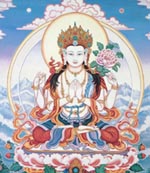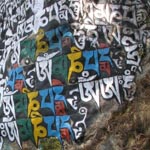Tibetan Buddhism: has
a special regard for the "Om Mani Padme Hum" mantra. It is associated with the four-armed form of Avalokiteshvara
(Tibetan "Chenrezig," Chinese
"Guanyin" or "Kwan Yin,"
the presiding deity of the mantra.The Dalai Lama is regarded as
a manifestation of Chenrezig.
mantra. It is associated with the four-armed form of Avalokiteshvara
(Tibetan "Chenrezig," Chinese
"Guanyin" or "Kwan Yin,"
the presiding deity of the mantra.The Dalai Lama is regarded as
a manifestation of Chenrezig.
In Tibet.and in the Tibetan community in Dharmasala, India, one comes
across huge piles of rocks each carved with "Om Mani Padme Hum."
Big boulders may be covered with "Om Mani Padme Hum" sometimes
in the symbolic six colors:
 white, green, yellow, red, blue, and black.
white, green, yellow, red, blue, and black.
Tibetan prayer wheels are turned day and night, each revolution
signifying a repetition of the mantra,written many times on paper concealed
within.

Tibetans can be seen with malas (strings of 108 prayer beads, softly
reciting the mantra.
In the transliteration of Sanskrit into Tibetan, the "Ni"
is written backwards, indicating the higher pitched tone for this
syllable in Sanskrit.